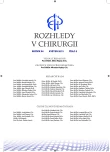Perspective of patients undergoing surgery for secondary peritonitis
Authors:
P. Majtan; J. Neumann; P. Kocian; J. Hoch
Authors‘ workplace:
Chirurgická klinika 2. LF UK a FN Motol, přednosta: prof. MUDr. J. Hoch, CSc.
Published in:
Rozhl. Chir., 2015, roč. 94, č. 5, s. 199-203.
Category:
Original articles
Overview
Introduction:
Peritonitis is a life-threatening disease with high mortality and morbidity. The prognosis depends on patient factors, the nature of the disease, and on diagnostic and therapeutic methods. The goal of our study was to perform a retrospective analysis of a group of patients with secondary peritonitis and to compare patients with non-stercoral peritonitis and those with stercoral peritonitis, and finally, to determine the prognostic value of the MPI prognostic index.
Methods:
We analysed 124 patients who had undergone surgery for secondary peritonitis during the years 2012–2013. We divided the patients into two groups. Group A comprised patients with non-stercoral peritonitis and group B consisted of patients with stercoral peritonitis. We compared the two groups and predicted the peritonitis outcome using the Mannheim Peritonitis Index (MPI).
Results:
The complete sample of 124 patients consisted of 70 men and 54 women. The average age of the patients was 63 years and the average length of hospitalization was 18 days. In total, 18 patients (15%) died during their hospitalization. The average MPI score was 19, which correlates to an 18% mortality rate prediction. In group A, which consisted of 68 patients with non-stercoral peritonitis, the average age was 59 years and the average length of hospitalization was 12 days. Two patients (3%) from this group died during hospitalization. The average MPI score was 9, which correlates to a 9% mortality rate prediction. In group B, which consisted of 56 patients with stercoral peritonitis, the average age was 67 years and the average length of hospitalization was 25 days. 16 patients (29%) from this group died during hospitalization. The average MPI score was 29, which correlates to a 31% mortality rate prediction.
Conclusions:
The outcome of our comparison between the two groups is that group A with non-stercoral peritonitis had a significantly lower mortality, lower number of complications and a shorter length of hospitalization. Both basic clinical data and sophisticated scoring systems can be used for mortality prediction in peritonitis. The Mannheim Peritonitis Index, a simple scoring system, proved to be useful in our study.
Key words:
Stercoral peritonitis – Mannheim Peritonitis Index – mortality prediction
Sources
1. Koperna T, Schulz F. Relaparotomy in peritonitis: Prognosis and treatment of patiens with persisting intraabdominal infection. World J Surg 2000;24:32–7.
2. Lamme B, Boermeerester A, Reitsma B, et al. Metaanalysis of relaparotomy for secondary peritonitis. British Journal of Surgery 2002;89:1516–24.
3. Opmeer BC, Boer KR, van Rulet O, et al. Costs of relaparotomy on-demand versus planned relaparotomy in patiens with severe peritonitis: an economic evaluation within a randomized controlled trial. Critical Care 2010;14:R97.
4. Billing A, Fröhlich D, Schildberg F. Prediction of outcome using the Mannheim peritonitis index in 2003 patients. Peritonitis Study Group. Br J Surg 1994;81:209−13.
5. Biondo S, Ramos E, Fraccalvieri D, et al. Comparative study of left colonic Peritonitis Severity Score and Mannheim Peritonitis Index. Br J Surg 2006;93:616−22.
6. Fuegger M, Rogy M, Herbst F, et al. Validierungsstudie zum Mannheimer Peritonitis-Index. Chirurg 1988;59:598− 601.
7. Tudor RG, Farmakis N, Keighley MRB. National audit of complicated diverticular disease: analysis of index cases. Br J Surg 1994;81:730−2.
8. Biondo S, Pares D, Marti Rague J. Emergency operation for nondiverticular perforation of the left colon. Am J Surg 2002;183:256−60.
9. Shinkawa H, Yasuhara H, Naka S. Factors affecting the early mortality of patients with nontraumatic colorectal perforation. Surg Today 2003;33:13−17.
10. Gooszen AW, Tollenaar RAEM, Geelkeren R. H, et al. Prospective study of primary anastomosis following sigmoid resection for suspected acute complicated diverticular disease. Br J Surg 2001;88:693−7.
11. Huťan M, Potičný V, Baláž P. Moderné trendy v liečbe difúznych peritonitíd. Rozhl Chir 2000;79:171−4.
12. Ajaz M, Khurshid W, Latif D, et al. Mannheim Peritonitis Index and Apache II – Prediction of outcome in patients with peritonitis. Turkish J of Trauma & Emergency Surg 2010;16:27−32.
13. Demmel N, Muth G, Maag K, el al. Prognostic scores in peritonitis: the Mannheim Peritonitis Index or Apache II. Langenbecks Arch Chir 1994;379:347−52.
14. Slaninka I, Páral J, Chobola M, et al. Peritonitidy způsobené perforací trávicí trubice – analýza gerontologické skupiny pacientů. Rozhl Chir 2009;88:656−61.
15. Bielecki K, Kamiński P, Klukowski M. Large bowel perforation: morbidity and mortality. Tech Coloproctol 2002;3:177−82.
16. Váňa J, Johanes R. Perforácie hrubého čreva. Rozhl Chir 2004;83:88−92.
17. Chandra V, Nelson H, Larson DR. Impact of primary resection on the outcome of patients with perforated diverticulitis. Arch Surg 2004;139:1221−4.
18. Makela JK, Kiviniemi H, Laitinen S. Prognostic factors of perforated sigmoid diverticulitis in the elderly. Digestive Surgery 2005;22:100−6.
19. Westaby S, White S. Wound infection. In: Westaby S. Wound care. Toronto 1986:71−83.
20. Hayato A, Ken-ichi M, Keisuke M, et al. Validation of the estimation of physiologic ability and surgical stress score for maintenanace hemodialysis patients undergoing elective abdominal surgery. Digestive Surgery 2014;31:269−75.
Labels
Surgery Orthopaedics Trauma surgeryArticle was published in
Perspectives in Surgery

2015 Issue 5
Most read in this issue
- Pancreatic metastases − diagnosis, radical surgery, complications and survival
- Endometriosis of the appendix presenting like acute appendicitis – a case report
- Intestinal volvulus caused by the ingestion of magnet balls: unexpected risk in children
- Femoropopliteal deep vein thrombosis and popliteal artery pseudoaneurysm as a complication of multiple hereditary osteochondromatosis
